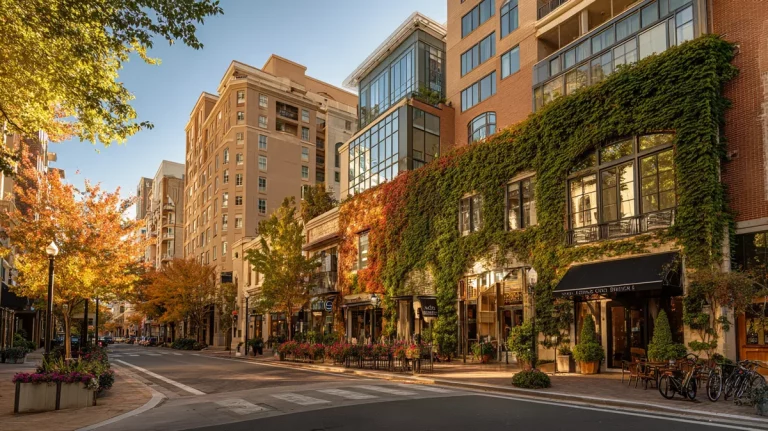Bethesda has the feel of a small town pressed right up against the edge of Washington, D.C.
On a Saturday morning, you might pass joggers on the Capital Crescent Trail, neighbors carrying coffee from Quartermaine, and visitors browsing the Bethesda Central Farm Market. By afternoon, the sidewalks around Bethesda Row fill with shoppers and diners, while the Metro carries commuters back and forth between the suburbs and downtown.
All of that convenience and energy comes at a price.
The overall cost of living in Bethesda, MD, is higher than the national average, and anyone moving to Bethesda should look closely at housing costs, transportation expenses, and other daily living expenses to understand what it takes to maintain your standard of living here.
Is It Expensive To Buy A Home In Bethesda, MD?
There’s a distinct rhythm to homebuying in Bethesda. Whether you’re wandering Bethesda Row on a Saturday or checking listings by the Metro, it becomes clear quickly that housing here doesn’t come cheap.
In July 2025, the median sale price for homes in Bethesda reached $1.275 million, reflecting a year-over-year rise of about 6 percent. Meanwhile, values based on a broader home-value index put the average home value closer to $1.14 million, up modestly over the past year.
What does this mean in practical terms? Entry-level options, typically condos or townhouses, offer a somewhat lower barrier to entry than detached houses, but affordability remains tight.
Average Price for Starter Homes in Bethesda, MD
For first-time buyers, the real estate market in Bethesda offers fewer entry-level options compared to other metro areas. Starter homes usually mean small condos or townhouses near Wisconsin Avenue or Battery Lane.
Detached homes at lower price points are rare, and market conditions often push values above what many would consider affordable.
Average Rent in Bethesda, MD
As of July 2025, the average asking rent for apartments hovered around $2,800 per month, for spaces averaging about 915 square feet.
A month earlier, broader market tracking showed one-bedroom units typically listing in the mid‑$2,400 range and two-bedroom places closer to $3,900. Those who browse rentals along Elm Street or Westmore come to see just how fast those numbers climb once you add walkability, updated finishes, or a spot near the Metro.
These figures suggest that “average monthly rent” here isn’t just a number. It reflects the true cost of living in Bethesda’s rental market.
What Are The Taxes in Bethesda, MD?
Taxes form a major part of the cost-of-living index published for Maryland communities.
Residents in Bethesda pay the statewide 6% sales tax and the Montgomery County local income tax, which is 3.20% for 2025.
Property taxes are set by the county and vary slightly depending on whether a property falls within the Bethesda Urban District.
How High Are Property Taxes in Bethesda, MD?
For a home in Bethesda valued at $800,000, the county’s 2025 levy schedule translates to about $8,900 per year in property taxes. Properties inside the Bethesda Urban District can be slightly higher.
Anyone buying a home in Bethesda should confirm their exact rate through the county’s Real Property Tax portal.
What Are the Average Monthly Utility Bills in Bethesda, MD?
Utilities add another layer to the MD cost of living.
According to the Energy Information Administration, the average monthly electricity bill in Maryland was $148 in 2023. Washington Gas typically runs $70 to $75 per month in the winter for a modest home, while WSSC Water estimates for a household using 4,000 gallons are around $89 monthly. Trash fees for county-serviced homes are billed at about $56 annually on property tax statements.
Transportation expenses vary depending on how you commute. Bethesda Metro connects directly to downtown D.C., and Ride On buses are currently fare-free. For drivers, gas prices, parking fees in Bethesda’s Parking Lot District, and tolls on I-270 can add significant monthly costs.
How Much Should I Budget for Groceries in Bethesda, MD?
Groceries are another key factor in living expenses.
The Bureau of Labor Statistics shows food prices in the Washington metro area rose 1.4% in July 2025 compared to the previous year.
While national USDA food plans suggest about $1,000 monthly for a family of four on the Thrifty plan, Bethesda households often spend more due to store options like Harris Teeter, Trader Joe’s, and Whole Foods, as well as specialty shopping at the Bethesda farmers market.
What is the Median Household Income in Bethesda, MD?
Bethesda remains among Maryland’s most affluent neighborhoods. As of the latest figures in 2023–2025, the median household income sits right around $191,350 per year.
That’s well above the national average and really reflects the kinds of careers anchored here, from federal work and healthcare to consultancy and research, that shape both buying power and the character of Bethesda real estate.
Recommended Income to Live In Bethesda, MD
What it takes to live comfortably in Bethesda depends on whether you’re renting an apartment or buying a home.
At the median rent of $2,578, a household would need to earn roughly $103,000 a year to keep housing near the 30-percent-of-income rule of thumb. Buying pushes the bar higher.
A $500,000 condo with a standard down payment works out to about $3,000 a month once you add the mortgage and property taxes, which lines up with an income of around $120,000.
For an $800,000 home, monthly costs land closer to $4,800, which means a household income of $190,000 to avoid being stretched too thin.
These are rough estimates, but they give a clear picture of what it takes to keep pace with the Bethesda market.
FAQs About the Cost of Living in Bethesda
Yes. Housing costs and rent prices are significantly higher than national figures, while goods and services follow metro D.C. pricing trends.
Use the state’s Real Property Search to confirm your assessment, then cross-check on the county’s tax account portal to see the total levy and any special district charges.
Many residents rely on public transportation. The Bethesda Metro station connects to downtown, and Ride On buses are currently free. For those who work outside the transit corridors, a car may still be necessary, with commuting costs added to the budget.
The most reliable approach is to use official data: the regional CPI for consumer goods, ACS for housing and income, and EIA for utilities.
Most renters can expect water and sewer to be included, but electricity remains separate. A one-bedroom apartment might run $100 a month for Pepco service, while gas usage depends on whether your unit has a gas stove or heating system.




